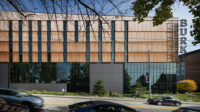Once upon a time, in the affluent Druid Hills neighborhood of Atlanta, a dark, forbidding forest bordered the Fernbank Museum of Natural History. But now, thanks to thoughtful interventions by local landscape architect Sylvatica Studio, an inviting path winds into the woods, allowing visitors a privileged view of the wild, including access for the first time to a rare stand of pristine old-growth Piedmont forest.
Additional Content:
Jump to credits & specifications
On a 16-acre section of the museum’s property, Sylvatica and its collaborators created the WildWoods—a lightly landscaped wooded area accessible on an elevated boardwalk that meanders down a hill and through a lush creek-side meadow, to connect with a rustic trail into Fernbank Forest. Just a few steps onto the gently sloping path, you are surrounded by forest, where dappled light and the gentle rustle of branches replace the sights and sounds of the bustling museum. “We were trying to change visitors’ perception of going out into nature,” says Susan Stainback, Sylvatica’s founder. “We hope this experience inspires curiosity and gets people to reexamine the forest.”
Sylvatica worked with architects Perkins+Will and engineers Uzun+Case on the walkway, which, rising as high as 35 feet above grade, is supported by a structure of horizontal glulam beams and steel columns. The elevation provides a thrill—and a unique perspective on the trees: where else do you get a close-up view of the trunks of tulip poplar, beech, or oak trees nearly a dozen yards up? Measuring roughly a mile, the boardwalk fulfills the institution’s goal of unifying its campus, while the larger master plan (completed with consultant landscape architecture firm Reed Hilderbrand) expands the educational facilities and addresses the proliferation of invasive plant species.
The museum’s property was preserved in the 1930s by Emily Harrison, a conservationist whose family originally owned the land. But since the mid-1960s—nearly three decades before the institution’s Graham Gund–designed building was completed—65 of the 115 total acres were leased to the local school district. Knowing that parcel would return to their control in 2012, the museum leadership embarked on a strategic plan to make the entire property accessible to visitors. “We were always planning for that transition,” says president and CEO Jennifer Grant Warner.
Fernbank selected Sylvatica for their light-on-the-land approach and charged the firm with physically and programmatically connecting the museum to the forest. “We wanted to break with the formal programming inside the building,” she says, “and provide an immersive experience.”
With planks made from coumarou, a Brazilian teak, the boardwalk is enclosed on its sides by a flexible steel net topped with sturdy ipé handrails. The walkway varies in width and includes several areas meant for lingering, including a 30-foot-tall biomimetric “pod”—a semi-enclosed structure with benches and uplighting, inspired by flowers of the tulip poplar and articulated with cedar louvers. A second, smaller pod meant to resemble the fronds of a fern provides a more intimate place in which to stop for a rest. (Sylvatica conceptualized the forms, then designed them in more detail in collaboration with Perkins+Will and Uzun+Case.)
Views from these scenic outlooks are framed to focus a visitor’s gaze up into the canopy of the trees, out to the densest parts of the forest, and down on the restored riparian lowlands. By compressing the slats on certain sides of the pods, the designers ingeniously obscured sight lines to the museum’s mechanical plant and other more programmed areas of the WildWoods, including a jungle gym–like structure, a screened-in outdoor classroom, and an interactive water feature play area, built atop an underground detention pond.
As much as Sylvatica’s interventions benefit visitors, they’re also strengthening the Fernbank ecosystem. The project included the planting of more than 100 varieties of native plants after the removal of great quantities of invasive species. (The museum opted for time-intensive manual extraction, rather than using herbicide, out of an abundance of caution for the health of amphibians living in the area’s watershed.) Now lush, waist-high spreads of River Oats, Beaked Panic Grass, Indian Grass, Swamp Hibiscus, and Switchgrass grow alongside the creek, swaying in the breeze as they filter water and attract pollinators. “The increased biodiversity is beneficial for the health of the forest,” says Stainback. The institution is even offering free memberships to owners of adjacent properties who remove non-native invasive vegetation from their yards.
Before the WildWoods project, the forest was inaccessible to museumgoers. “People were so curious about what was there,” says Warner; since the soft opening in September 2016, she reports there’s been an increase in visitors, members, and in “dwell time,” or how long people stay. The undertaking has radically enhanced Fernbank’s mission: to inspire greater appreciation for the natural world.
CreditsLandscape architect: Sylvatica Studio — Susan Stainback, Ryan Jenkins, Curtis Alter
Associate architect: Perkins+Will—Jared Serwer, John Poelker
Engineers: Uzun+Case, CFD Structural Engineering (structural); Long Engineering (civil)
Consultants: Reed Hilderbrand (master planning); Steven Handel (ecological); Thinkwell Group (exhibition design); Tunnell and Tunnell (historic)
General contractor: Van Winkle Construction |
SpecificationsMesh guardrail Carl Stahl DecorCable
Lighting Sistemalux |





















